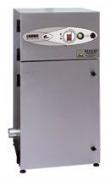 Add My Company
Add My Company
Sign In

Laser coding and marking of plastics, not a problem with Purex laser fume extractor
The use of lasers in the packaging industry, predominantly to code products with use by dates and batch codes is growing. The laser burns away a layer of material in order to produce a mark. The length and depth of the mark determines how much dust and fume is released into the atmosphere. At first glance this may not seem to be a problem, but in a plant coding millions of products per week, the volume of dust and fume generated is considerable.
The importance of an effective fume extraction and purification system is often underestimated. Many engineers understand that extraction is necessary from a health and safety point of view, as laser marking, welding and cutting, produce hazardous dust and fume that cause long-term illnesses like cancer and occupational asthma. The production benefits brought about by using a quality fume extraction system are invaluable in a production environment.
Of particular interest is the new LASEREX range of machines from Purex, which have been specifically designed to combat the harsh conditions caused by marking or coding plastics. For example, PVC and PET release both particles and fumes when marked with a laser. The particles are sticky and can block normal filters within minutes. The fumes released are toxic, and include Hydrogen Chloride and Benzene. HCl fumes are a particular problem as they combine with moisture in the air to form Hydrochloric Acid that attacks and corrodes machinery. These particular plastics are used in a wide variety of products from wrappers and bottles to tablet blister packs.
The LASEREX systems employ a multi-stage filtration system to combat hazardous materials and to increase filter life. Air is drawn in from the process using specifically designed extraction nozzles to prevent particles and fume building up around the laser head and the product. Particle build up can deflect the laser beam, resulting in blurred or distorted marks and therefore increased reject rates. Cool particles can come into contact with the laser, potentially cracking the lens, which would obviously incur replacement costs and lengthy production downtime. Another problem (particularly in the food and pharmaceutical industries) is that particles generated by marking can settle onto the product, again leading to increased reject rates.
A recent Purex installation at a bottling plant in France has seen production rates triple overnight. Phil Mullins, MD of PUREX International explains, "This particular customer was marking soft drink bottles at the rate of 20,000 per hour. The line could potentially operate at 70,000 per hour, but due to insufficient extraction, the product throughput had to be limited as the debris build up at high speeds was causing the mark to blur and become unreadable. We surveyed the process and installed a Purex system that allowed the company to run at full production, with obvious results in the lines profitability."
Once contaminated air is drawn from the process into a Purex machine, it is passed through a patented "concertina prefilter". The life of a filter is directly proportional to the area of filter media it contains, therefore the unique design of the concertina offers around 10 times the life of a normal filter. If you consider that (due to health and safety legislation) the production line has to be stopped in order to change a filter, the resultant savings in terms of downtime are tremendous.
In the case of PVC marking, Hydrochloric Acid has been proven to corrode packaging machinery, rendering it inoperable. Purex systems prevent this happening in a unique way. The acid is removed from the atmosphere and condenses inside the prefilter to form a liquid that is absorbed safely in a specially positioned chemical pad. The Purex machine itself is manufactured from chemically resistant materials to prevent corrosion.
Once through the
For more information on Laser Coding And Marking Of Plastics, Not A Proble talk to Purex International Ltd
Enquire Now
List your company on FindTheNeedle.
